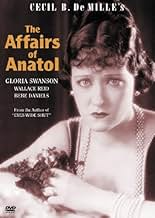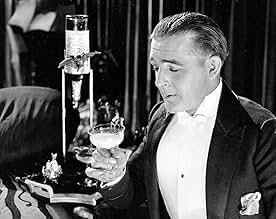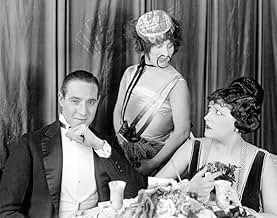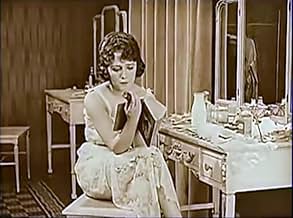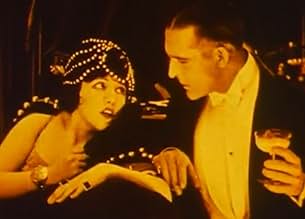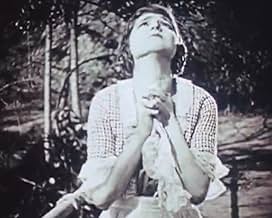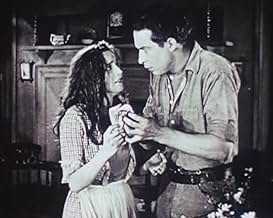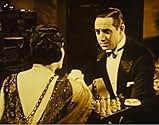VALUTAZIONE IMDb
6,6/10
1398
LA TUA VALUTAZIONE
Aggiungi una trama nella tua linguaSocialite Anatol Spencer seeks a better relation than he has with his wife. He sets up the friend of his youth Emilie in an apartment and she two-times him; he comforts near-suicidal Annie a... Leggi tuttoSocialite Anatol Spencer seeks a better relation than he has with his wife. He sets up the friend of his youth Emilie in an apartment and she two-times him; he comforts near-suicidal Annie and she robs him.Socialite Anatol Spencer seeks a better relation than he has with his wife. He sets up the friend of his youth Emilie in an apartment and she two-times him; he comforts near-suicidal Annie and she robs him.
- Regia
- Sceneggiatura
- Star
- Premi
- 1 vittoria in totale
Laura Anson
- Vivian's Maid
- (non citato nei titoli originali)
Alma Bennett
- Chorus Girl
- (non citato nei titoli originali)
William Boyd
- Guest
- (non citato nei titoli originali)
Shannon Day
- Chorus Girl
- (non citato nei titoli originali)
Julia Faye
- Tibra
- (non citato nei titoli originali)
Elinor Glyn
- Bridge Player
- (non citato nei titoli originali)
Winter Hall
- Dr. Johnston
- (non citato nei titoli originali)
Raymond Hatton
- Great Blatsky - Violin Teacher
- (non citato nei titoli originali)
Fred Huntley
- Stage Manager
- (non citato nei titoli originali)
Recensioni in evidenza
The plot and an analysis is elsewhere here well done with Ron Oliver's review. Suffice to say that the hand-tinted titles and the sepia-toned film itself, hinting at reds along with its browns are a real joy to behold. Seeing so many luminaries in one film is also a treat - Reid, Swanson, Moran, Daniels, Ayres.
However, the film could easily have been a half hour shorter with less wear and tear on the viewer and with virtually little loss in the morality tale or sense of the work. It's all enjoyable but it does drag a bit.
Grapevine and Kino both have excellent prints. Important for its director and his non-epic style as well as for the presence of Reid and Swanson, but far from a great or important film.
However, the film could easily have been a half hour shorter with less wear and tear on the viewer and with virtually little loss in the morality tale or sense of the work. It's all enjoyable but it does drag a bit.
Grapevine and Kino both have excellent prints. Important for its director and his non-epic style as well as for the presence of Reid and Swanson, but far from a great or important film.
The Affairs of Anatol (1921)
A long, involved, romantic and slightly moralizing movie about a really good hearted man caught between two women. That's the reason to watch it, that and Gloria Swanson in the lead as the wife. The other woman (Wanda Hawley) is a bit of a siren, and our good fellow is trying to be a charitable fellow with her, and only gets himself in trouble. She plays him like a child.
The year, 1921, is just at the point where the silent film is solidifying and getting sophisticated in a modern sense. There is still a lot of static (fixed) camera in this one (even though one of the photographers was the legendary Karl Struss). This puts the emphasis on the acting, which rises to the occasion. The copy I saw had some great hand colored title cards and some scenes that were toned in rich yellows or other colors, which made it all quite fun. The conflict between the two women, and the intrusion of another man or two, make this a classic soap opera kind of drama, well done and clear enough to follow once you get the basic flow. There are sort of two halves, and the second part out in the country is a nice shift even though the theme remains similar.
Of interest? The director, Cecil B. De Mille, had a hugely influential and long career, and this is toward the beginning, and it shows his tendency to find the popular themes that audiences would connect with, rather than push technical or aesthetic boundaries. Some might call him a populist, interest above all in success, but he was an expert director who knew how to make a movie really coherent, handling the story and actors with precision and a sympathetic feel. And the subject matter here is actually a bit edgy--a married man hanging out with a woman in her most intimate spaces. The play of the "bad" woman against the "good" one is a little expected, of course, but it's such a heartwrenching problem for this nice guy who just wants to help (or so he says), it's painfully enjoyable to watch.
A long, involved, romantic and slightly moralizing movie about a really good hearted man caught between two women. That's the reason to watch it, that and Gloria Swanson in the lead as the wife. The other woman (Wanda Hawley) is a bit of a siren, and our good fellow is trying to be a charitable fellow with her, and only gets himself in trouble. She plays him like a child.
The year, 1921, is just at the point where the silent film is solidifying and getting sophisticated in a modern sense. There is still a lot of static (fixed) camera in this one (even though one of the photographers was the legendary Karl Struss). This puts the emphasis on the acting, which rises to the occasion. The copy I saw had some great hand colored title cards and some scenes that were toned in rich yellows or other colors, which made it all quite fun. The conflict between the two women, and the intrusion of another man or two, make this a classic soap opera kind of drama, well done and clear enough to follow once you get the basic flow. There are sort of two halves, and the second part out in the country is a nice shift even though the theme remains similar.
Of interest? The director, Cecil B. De Mille, had a hugely influential and long career, and this is toward the beginning, and it shows his tendency to find the popular themes that audiences would connect with, rather than push technical or aesthetic boundaries. Some might call him a populist, interest above all in success, but he was an expert director who knew how to make a movie really coherent, handling the story and actors with precision and a sympathetic feel. And the subject matter here is actually a bit edgy--a married man hanging out with a woman in her most intimate spaces. The play of the "bad" woman against the "good" one is a little expected, of course, but it's such a heartwrenching problem for this nice guy who just wants to help (or so he says), it's painfully enjoyable to watch.
The usual DeMille mix of sex, sin, and moralizing but with tongue firmly in place. Poor Anatol (Wallace Reid) is always "rescuing" women, much to the consternation of his wife Vivian (Gloria Swanson) who always has Max (Elliott Dexter) hanging around her.
The first rescue is of "a bubble-head jazz girl" named Emilie (Wanda Hawley) who is clearly a gold digger, She has poor old Gordon (Theodore Roberts) in her pocket but decides to go after Anatol who thinks he can redeem the poor girl. Meanwhile all she wants is a new victim. There's a great scene of redemption when Anatol tells Emilie she must throw away all her jewels in order to be cleansed. She immediately empties her jewel boxes and puts the empty boxes in a valise. They drive to the river where she throws away the empty boxes. Foolish Anatol believes her but learns the sad truth when he interrupts a wild dinner party Emilie is throwing.
Off to the country for purity and clean air, Anatol and Vivian are rowing in a river when a simple country girl Annie (Agnes Ayres) throws herself off a bridge. They dredge her out and revive her but Annie finds Anatol's wallet on the ground and steals it. After she is "saved" she runs home to husband Abner (Monte Blue) and replaces the money she stole from his church collection box. So much for country purity.
Back in the city Anatol decides to go out on the town, so Vivian decides to wear her :lowest gown" and "highest heals" and go out as well. Anatol falls into the clutches of the notorious nightclub star Satan Synne (Bebe Daniels) who lures Anatol into her den called "the Devil's Cloister." In the middle of vamping him, she gets a couple phone calls. It seems her husband is undergoing an operation for wounds suffered during the World War. When Anatol learns the truth, he gives Satan the money she needs to save her husband.
But back home, he finds Vivian has not come home from her night of clubbing. When she and Max finally come in a 9 AM he demands to know if she's be unfaithful. She refuses to answer. At that moment, a famous hypnotist (Theodore Kosloff) arrives and is compelled by Anatol to secretly put her in a trance and answer his questions. He does, but Max pleads with Anatol that to do this will forever ruin his marriage no matter what the answer is. Will Anatol force the issue? Reid and Swanson are terrific here as the stars, but the fallen women, Hawley, Ayres, and Daniels, all come off well also. Dexter and Blue have little to do. Roberts fumes and Kosloff looks mysterious. And yes that's Polly Moran as the nightclub entertainer.
The film has beautifully colored title cards and boasts nice tinting throughout. This is a must for silent film fans and was an important film for superstars Gloria Swanson, Wallace Reid, and Bebe Daniels.
The first rescue is of "a bubble-head jazz girl" named Emilie (Wanda Hawley) who is clearly a gold digger, She has poor old Gordon (Theodore Roberts) in her pocket but decides to go after Anatol who thinks he can redeem the poor girl. Meanwhile all she wants is a new victim. There's a great scene of redemption when Anatol tells Emilie she must throw away all her jewels in order to be cleansed. She immediately empties her jewel boxes and puts the empty boxes in a valise. They drive to the river where she throws away the empty boxes. Foolish Anatol believes her but learns the sad truth when he interrupts a wild dinner party Emilie is throwing.
Off to the country for purity and clean air, Anatol and Vivian are rowing in a river when a simple country girl Annie (Agnes Ayres) throws herself off a bridge. They dredge her out and revive her but Annie finds Anatol's wallet on the ground and steals it. After she is "saved" she runs home to husband Abner (Monte Blue) and replaces the money she stole from his church collection box. So much for country purity.
Back in the city Anatol decides to go out on the town, so Vivian decides to wear her :lowest gown" and "highest heals" and go out as well. Anatol falls into the clutches of the notorious nightclub star Satan Synne (Bebe Daniels) who lures Anatol into her den called "the Devil's Cloister." In the middle of vamping him, she gets a couple phone calls. It seems her husband is undergoing an operation for wounds suffered during the World War. When Anatol learns the truth, he gives Satan the money she needs to save her husband.
But back home, he finds Vivian has not come home from her night of clubbing. When she and Max finally come in a 9 AM he demands to know if she's be unfaithful. She refuses to answer. At that moment, a famous hypnotist (Theodore Kosloff) arrives and is compelled by Anatol to secretly put her in a trance and answer his questions. He does, but Max pleads with Anatol that to do this will forever ruin his marriage no matter what the answer is. Will Anatol force the issue? Reid and Swanson are terrific here as the stars, but the fallen women, Hawley, Ayres, and Daniels, all come off well also. Dexter and Blue have little to do. Roberts fumes and Kosloff looks mysterious. And yes that's Polly Moran as the nightclub entertainer.
The film has beautifully colored title cards and boasts nice tinting throughout. This is a must for silent film fans and was an important film for superstars Gloria Swanson, Wallace Reid, and Bebe Daniels.
Drawn to this by the irresistable and rare chance of seeing Wallace Reid and Gloria Swanson working together on a film, I had heard about it through reference books (and also about Swanson's recollections of the film not being happy due to feeling uncomfortable with Reid at the time), and expected exactly what I got - a fun piece with some nice touches (Gloria's playful mood before she feels slighted by Wanda Hawley's flapper girl; Reid trashing Hawley's apartment when he realises she did not have pure intentions towards him after all; Agnes Ayres and Reid sharing a kiss in the woods while Gloria has gone to fetch a doctor to attend to Ayres, 'half-drowned' when she left; and best of all, Bebe Daniels as the absurdly named Satan Synne who is really a domesticated pussy cat chasing young men for cash to help her sick husband). The Affairs ... also benefits from having a lovely series of colour tints throughout. A little overlong perhaps (and too much focus on Hawley at the expense of the other girls encountered by Tony) but another fascinating early piece from De Mille. Sad to think that Wallace Reid would be dead by early '23. The movies' loss.
This film is great fun, and often -- and I think intentionally, as in the 'Satan Synne' segment -- very funny: "an extravagant story that never by any chance could be taken seriously," as one contemporary reviewer approves. It's hard to sympathise with spoiled wife Vivian at first (a hard-edged performance by Gloria Swanson), but as the film goes on we start to realise that she does have a point.
This being a de Mille film, the costumes are of course fantastic; although it's actually not Swanson, the famous 'clothes-horse', who gets the best dresses here. Production values are elsewhere very high, as well, extending into beautifully-drawn title cards (in one case, with a live-action car actually driving across it!) and a lot of sacrificed furniture, while frankly, those jewelled flowers look almost worth losing a lover over...
But it's not all gloss and enjoyable silliness. There's some fine acting on display as well, not least from Wallace Reid as the well-meaning 'Tony' whose halo begins progressively to slip -- and, in a couple of telling little scenes, from Elliott Dexter as the overlooked best friend. (The little scene over the chessboard is a perfect illustration of the power of the silent screen: everything made explicit without a word.)
The picture's stage heritage shows up mainly in a few over-long title cards, where plot points are conveyed in one long 'speech'; at almost two hours in duration, it's also unbalanced in the direction of the first half, which could almost stand as a film on its own without its briefer 'sequels'. If Emilie is not to have a film of her own, there is perhaps a little too much time devoted to her.
But "The Affairs of Anatol" is well worth seeing -- not least, as an eye-opener for those like myself who associate C.B. de Mille with vast Biblical epics. This piece of froth and frivolity has more of the charm of a Harold Lloyd movie minus the slapstick; one can really see why 'handsome Wallace Reid' was a star; and there are just enough well-judged moments of genuine feeling among the spectacle and satire to make us care about the various minor players.
This being a de Mille film, the costumes are of course fantastic; although it's actually not Swanson, the famous 'clothes-horse', who gets the best dresses here. Production values are elsewhere very high, as well, extending into beautifully-drawn title cards (in one case, with a live-action car actually driving across it!) and a lot of sacrificed furniture, while frankly, those jewelled flowers look almost worth losing a lover over...
But it's not all gloss and enjoyable silliness. There's some fine acting on display as well, not least from Wallace Reid as the well-meaning 'Tony' whose halo begins progressively to slip -- and, in a couple of telling little scenes, from Elliott Dexter as the overlooked best friend. (The little scene over the chessboard is a perfect illustration of the power of the silent screen: everything made explicit without a word.)
The picture's stage heritage shows up mainly in a few over-long title cards, where plot points are conveyed in one long 'speech'; at almost two hours in duration, it's also unbalanced in the direction of the first half, which could almost stand as a film on its own without its briefer 'sequels'. If Emilie is not to have a film of her own, there is perhaps a little too much time devoted to her.
But "The Affairs of Anatol" is well worth seeing -- not least, as an eye-opener for those like myself who associate C.B. de Mille with vast Biblical epics. This piece of froth and frivolity has more of the charm of a Harold Lloyd movie minus the slapstick; one can really see why 'handsome Wallace Reid' was a star; and there are just enough well-judged moments of genuine feeling among the spectacle and satire to make us care about the various minor players.
Lo sapevi?
- QuizGloria Swanson admitted in an interview decades later that Wallace Reid's drug addiction scared her while they were making this film, and she avoided socializing with him because of it.
- BlooperIn the flashback sequence where Emilie is on a swing and two mirrors are set up to give repeated reflections of the action, the cameraman bending over his camera is visible a few times when the swing moves out of the way.
- Citazioni
Anatol Spencer: Let's not kiss any more, dear, until after breakfast.
- Versioni alternativeFilm Preservation Associates copyrighted a version in 1999 with a music score compiled and performed by Brian Benison. It was produced for video by David Shepard and ran 117 minutes.
- ConnessioniEdited into Don't Tell Everything (1921)
I più visti
Accedi per valutare e creare un elenco di titoli salvati per ottenere consigli personalizzati
Dettagli
- Data di uscita
- Paese di origine
- Lingua
- Celebre anche come
- Anatol: Five Kisses
- Azienda produttrice
- Vedi altri crediti dell’azienda su IMDbPro
- Tempo di esecuzione1 ora 57 minuti
- Mix di suoni
- Proporzioni
- 1.33 : 1
Contribuisci a questa pagina
Suggerisci una modifica o aggiungi i contenuti mancanti

Divario superiore
By what name was Fragilità, sei femmina! (1921) officially released in Canada in English?
Rispondi
